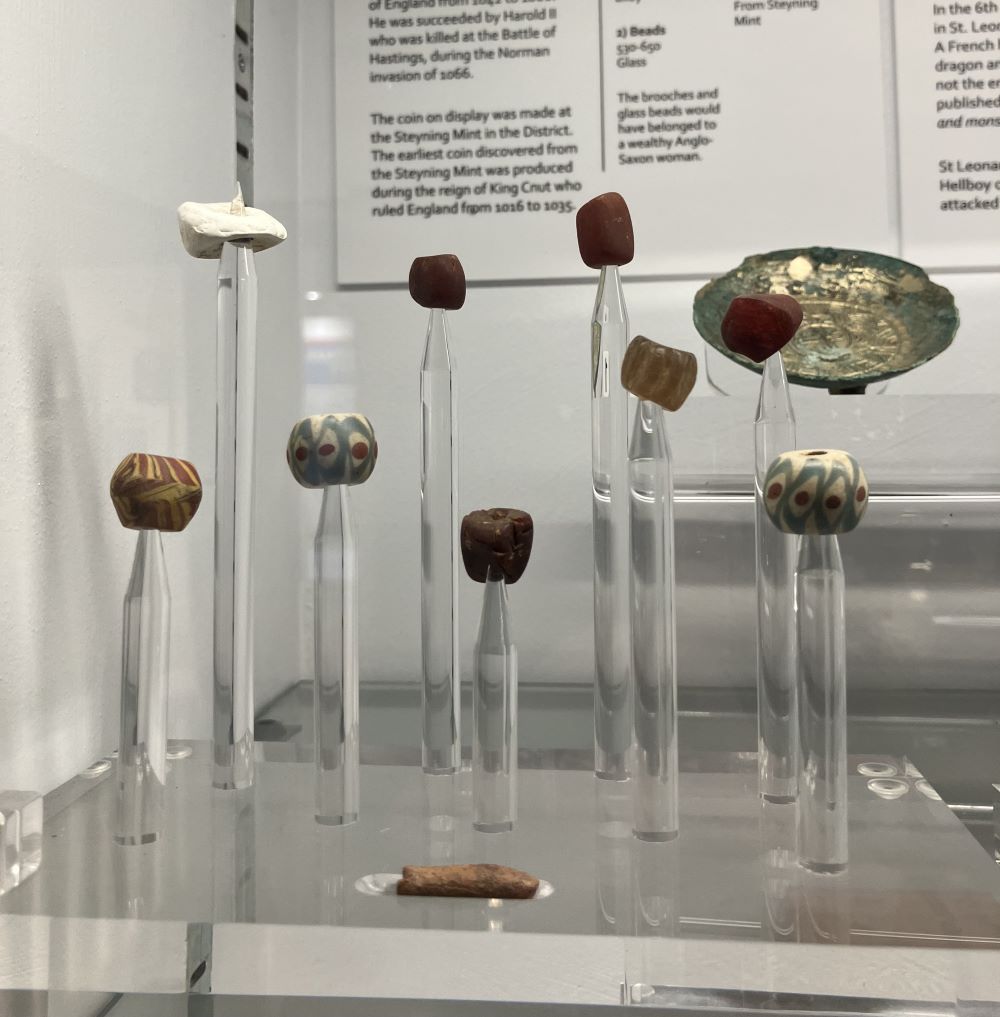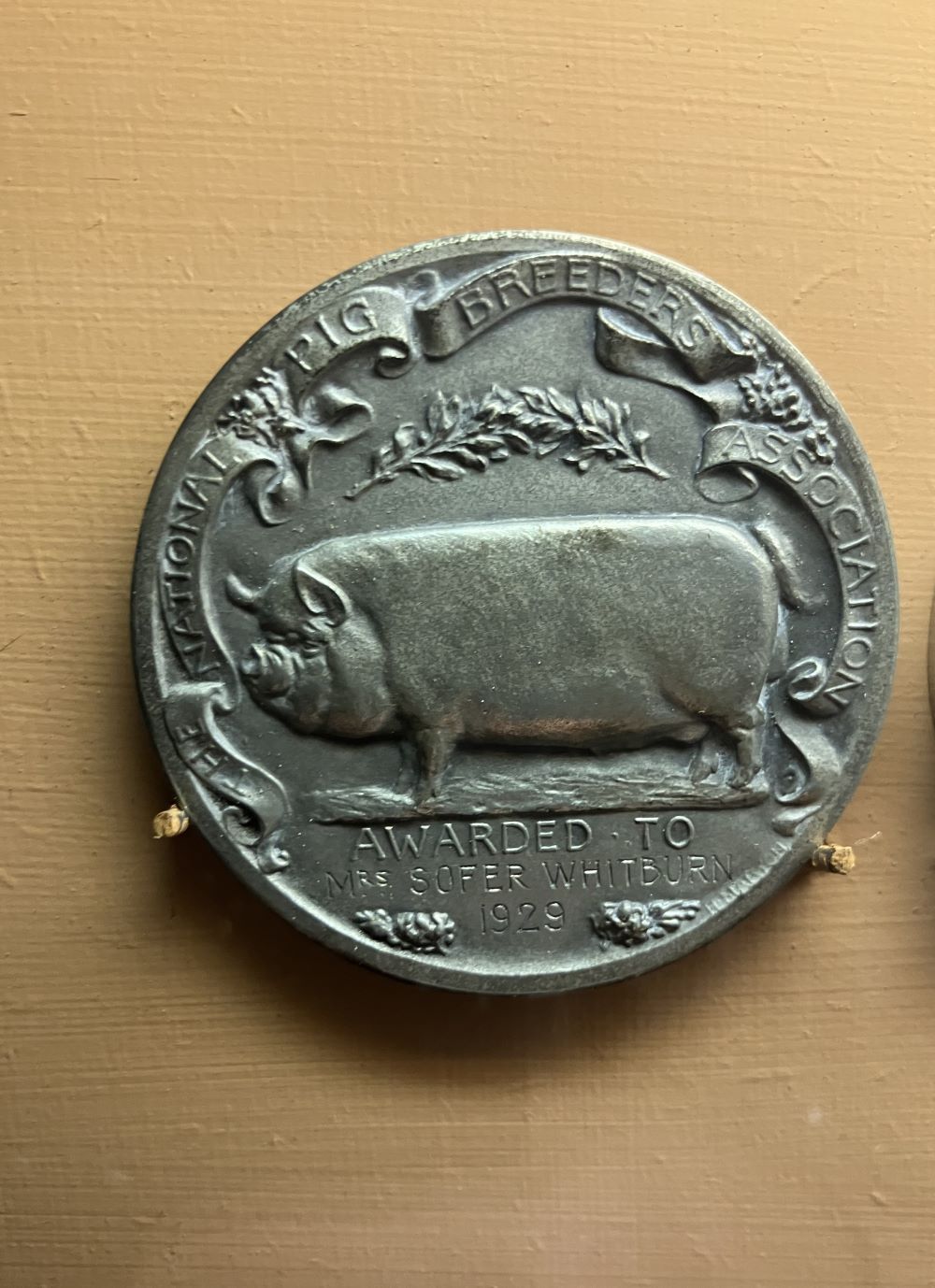
Our new Visitor Services Officer, Jess, discusses some of her favourite items in the Museum's collection.
Whither
When I step into the Library, one of the first objects to catch my eye is always a large oil painting on the left wall titled Whither (pictured above). This was painted in 1925 by Edward Bainbridge Copnall, a sculptor and painter who lived much of his early life in Horsham.
Whither depicts a funeral in a Horsham churchyard, the background includes some of the hills around Horsham alongside what is likely St Mary’s Church. If you closely examine the painting, you’ll notice how Copnall has blended elements of the fantastical (such as the ghoulish figure standing at the graveside) with more mundane scenes of daily life.
This painting is not the only work by Copnall displayed in the museum. The garden hosts a large sculpture by Copnall depicting of the crucifixion of Jesus, this was created using coal dust and resin.
Anglo-Saxon Beads
In 2015, a father and son using metal detectors discovered a number of Anglo-Saxon glass beads in West Sussex. They are estimated to have originated between 530 and 650. Despite their age, the beads still display vivid colours and patterns.
The beads were part of one of the most important Anglo-Saxon archaeological discoveries to be made in West Sussex. They were discovered alongside some saucer brooches, metal work and traces of textile. Analysis of these textile traces has indicated that the beads were buried with a woman wearing a woollen dress and linen head covering. She was likely wealthy within Anglo-Saxon society.

The National Pig Breeders Association Medal
The barn features a collection of medals awarded by agricultural societies in the 19th and early 20th centuries. These were donated to the museum by Mrs Hull Grundy in the 1970s. The medals span a range of agricultural organisations including the British Beekeepers Association and the Shire Horse Society, showcasing the wide social reach agricultural societies gained in the 19th century.
My favourite amongst the collection is a medal from The National Pig Breeders Association. This is primarily owing to the intricate engraving on the front of the award, which depicts a sturdy looking pig. An inscription notes that the medal was awarded to Mrs Sofer Whitburn in 1929.

WW1 Chess Set
Towards the back of the museum’s bottom floor, there is a chess set on display. The pieces are carved from wood and date from 1914 -1918. The set is thought to have originated in a First World War POW camp by Horsham, potentially by some of the Italian POWs who were kept in captivity there.
It was not irregular for POWs to turn to crafting as a way to pass time in captivity or earn some income. In the museum’s Second World War gallery there is green wooden parrot toy on display. This was built and sold around 1946 by a German POW held near Horsham. Italian POWs imprisoned locally in this period were also known to weave and sell baskets.

Battle over Chanctonbury
Battle over Chanctonbury is a mixed media etching which depicts a struggle between the devil and an angelic figure. In the background you can see a circle of trees resembling those at Chanctonbury Ring. Chanctonbury Ring is located on the South Downs in Horsham District and bears evidence of prehistoric use. The site was later host to two Romano-British temples. With this rich history, the area has long been the subject of local legends. The artist behind this etching - Alison Millner-Gulland – lived near to Chanctonbury Ring and was likely inspired by these legends when she created the piece in 1980.
As we head from summer towards autumn, I’ve enjoyed learning more about the mythology surrounding Chanctonbury Ring during my research for our Halloween events. A popular legend tells of how the devil can be summoned if one runs widdershins (opposite to the course of the sun) round the ring seven times. Once the devil has appeared, he will offer you a bowl of soup or porridge in exchange for your soul. Other versions of this tale instead state that the spirit of a druid or Julius Caesar will appear to you.

Published: 10 Sep 2024
